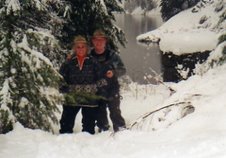All around are rocks, huge wind swept free form sandstone sculptures created by the tenacious Mediterranean breezes that buffet these islands nearly constantly in the fall and winter. This is the Island of La Maddalena a small archipelago off the northeast coast of Sardinia. The temperatures are moderate not giving a lot of rain, surprisingly, but the wind is constant.
The native junipers are tough ragged bushes that have adapted well to the shallow soil and minimal moisture. Their local neighbors are Palm trees and cacti that are hold onto the earth by gripping the stones making up the landscape. Pines, we haven’t been able identify yet, break the horizon in several sizes and shapes.
Smaller plants that also grow wild including the herbs thyme and rosemary. The thyme is a little farther inland but the rosemary bushes around us are huge. Sometimes several feet across and five to six feet high. One would think the native grass’ would be short, close the earth for protection from the wind, and there are some of those. But, in addition is tall wide blade swords reaching up nine to ten feet with beautiful brush -like seed heads on inch thick stalks two feet taller. I don’t know how many varieties of the tall grass there is but we keep seeing new ones as we walk and drive the island. Wild aloe grow to four to feet next to the grass and trees. Mirto, a large bush with blue berries, clings to the stones. A local liqueur is made of these native berries and is bottled in cork bottles from the local Cork Oak trees found on Sardinia.
When this land was first occupied by modern man in the early eighteenth century each man was given as much property as he could build a wall around. Guess what was used for these asymmetrical walls that line the island partitioning old claims to the land. Small stone and concrete cottages with tile roofs dot the hills used as homes and out buildings of these old settlers. Later building construction passed from stone to concrete to block and mortar of today. Still the roofs are tile, held together with a sand and cement seal. I can’t help but wonder how much the gables, slopes, ridges and valleys that top the houses but weigh. All the windows and doors have louvered shutters for protection from the big winds when they come on shore.
Sheep and fishing was the original form of income on this island. Merchants that support those industries built the town on the seafront. The old town dating from the early seventeen hundreds is a mix of two to three story buildings and narrow streets only wide enough for one small car. One he first floor are shops with business’ and homes in the upper stories.
More later about the people and our travels here.
.
Friday, December 22, 2006
Subscribe to:
Post Comments (Atom)

No comments:
Post a Comment